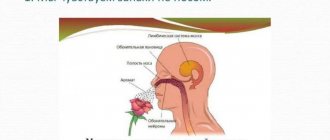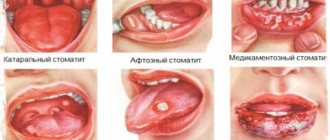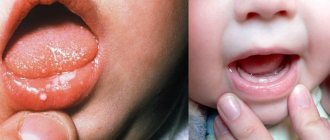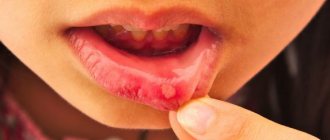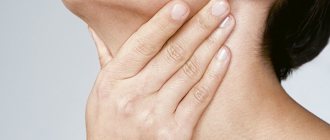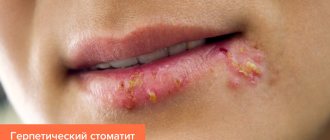Pharmacology and pharmacodynamics
The medication has an antimicrobial effect and also has anti-inflammatory and analgesic effects.
The active ingredient choline salicylate relieves pain and inflammation at the site of application of the gel. The analgesic effect lasts for an average of 4-7 hours.
The second active element has a powerful antiseptic effect. Effectively copes with harmful bacteria.
The structure of the ointment promotes its rapid absorption into tissues, reaches the nerve endings in a short time and remains on the oral mucosa for a long time. Almost does not enter the blood.
Holisal
Cholisal (choline salicylate + cetalkonium chloride) is a combination drug from a Polish pharmaceutical company that has antibacterial, antimicrobial and analgesic effects and is used in dental practice. Available in gel form. Quickly relieves pain and destroys pathogenic bacteria without having a negative effect on the saprophytic microflora. The complex effect of the drug is achieved through the combination of choline salicylate and tsetalkonium chloride. The first of the two substances belongs to non-steroidal anti-inflammatory drugs that suppress the release of mediators of pain and inflammatory reactions. The gel-like dosage form allows choline salicylate to quickly enter and remain in the inflammatory focus for a long time. Cetalkonium chloride is a disinfectant and antimicrobial agent that extends its effect to staphylococci, streptococci, E. coli, pseudomonas, Proteus, bacteroides, peptotreptococci, Klebsiella, clostridia, candida and herpes simplex virus. The characteristics of the dosage form ensure good penetration of the active substances, and the auxiliary ingredients potentiate the antimicrobial effect. The drug does not contain antibiotics, which can suppress both pathogenic and saprophytic microflora at the same time, thereby disturbing the bacterial balance in the oral cavity. Thanks to its disinfecting properties, the drug prevents secondary infections of the oral cavity. The analgesic effect of Cholisal develops within 3 minutes after application of the gel. The duration of action of the drug can reach 8 hours. A four-day course of medication is sufficient for complete healing of erosive lesions of the oral mucosa that arose as a result of wearing braces or dentures.
Five days is enough to eliminate increased bleeding and eliminate unpleasant odor in periodontal diseases. The small size of the tube ensures practicality and ergonomics. The drug is widely used in pediatric practice in patients over 1 year of age. The essential anise oil included in Cholisal improves organoleptic characteristics and enhances the anti-inflammatory and disinfecting effect (the aromatic ester anethole is “responsible” for this). A single dose of the drug is a gel “sausage” 1 cm long (for children – 0.5 cm). The gel is rubbed into the inflamed area with soft and light movements. Frequency of use – 1-2 times a day. Before using the drug, you must brush your teeth. You should refrain from eating or rinsing your mouth for half an hour after the procedure. The duration of pharmacotherapy for periodontitis is 10-14 days (for a mild form of the disease), 30 days (for a severe form). The optimal time to take it is after meals and before bedtime. Cholisal is not absorbed into the systemic bloodstream, and therefore has virtually no clinically significant side effects, with the exception of allergic reactions manifested by mild itching and burning at the site of application. The only direct contraindication to the use of Cholisal is hypersensitivity to the active or auxiliary components of the drug. Pregnant and lactating women may take the drug under medical supervision. Cholisal does not contain sugar and can be used in people with diabetes. Cases of drug dosage were not recorded.
What does Cholisal help with?
The gel is able to cope with inflammatory processes occurring in the oral cavity and various injuries. The drug should be taken for the following conditions:
- stomatitis;
- mechanical injuries and other damage resulting from wearing prostheses;
- for severe pain, as well as for prophylactic purposes after dental surgery;
- teething in babies;
- gingivitis.
How to tell when teeth are coming through
Teething in infants up to one year old and in older children can be accompanied by a whole range of symptoms, which parents often confuse with signs of other diseases.
- The child becomes irritable and capricious.
During the period of teething, the baby is not yet able to say or show that something hurts. Meanwhile, discomfort can bother him all the time. Therefore, if your baby is constantly fussy and crying, it’s time to examine his gums. - The gums are swollen and red.
If you find such a symptom, this is a sure sign that teeth will appear soon and you might want to think about using gum gel for teething. - The temperature has risen.
Unfortunately, this symptom often worries children. Fever is the body's response to gum inflammation. Therefore, it is better if the gel has an anti-inflammatory effect during teething in children. - The baby sucks his fingers and chews on toys.
The fact is that when teething, the gums itch and thereby bother the baby. To avoid the development of infection, it is better to give your child a special teething toy, which should be washed more often. - Salivation increased.
This is another sign that teeth will appear soon. It is better to wipe the saliva carefully to avoid irritation around the mouth. - The child does not sleep well and refuses to eat.
Teeth are cut not only during the day, but also at night. Therefore, the baby cannot fall asleep or often wakes up in pain. Refusal to eat also worries parents. Teething pain gel helps to cope with these problems. - The baby rubs his ears and cheeks.
This is because the discomfort and pain can extend beyond the gums. - A slight cough appeared.
The symptom occurs due to increased salivation. There is no need to worry if there are no other signs of a cold or allergy. - Hematomas on the gums.
This also happens. As a rule, hematomas resolve on their own. A cold compress will help relieve the condition.
How to use Cholisal gel
The instructions indicate that the ointment is for external use only. It should be applied exclusively to the affected area of the mouth.
The product should be applied 20 minutes before or after meals. You can also rub the ointment in before going to bed. The procedure can be repeated up to 3 times a day. It will be enough for a child to use 0.5 cm, and for an adult – 1 cm.
If a person suffers from periodontal disease, then the ointment can be placed in the gum pockets that appear or effective compresses can be made.
General treatment for stuck lips
Increasing immunity and strengthening it:
- vitamins of groups B, A and C in the form of vitamin complexes or an increase in the diet of foods containing them:
- B vitamins contain: milk, cheese, cottage cheese, broccoli, fresh peas, green beans, spinach and bran.
- trace elements in foods: peaches, pomegranates, nuts, parsley, asparagus, buckwheat, seafood, pumpkin seeds.
If seizures do not go away for a long time, you need to understand the common causes of decreased immunity, chronic diseases and influence them.
Treatment of jam with folk remedies
To treat mouth congestion, traditional medicine came up with the idea of using sulfur from the external auditory canal. The human body always stands guard over its interests so that nothing foreign or pathological gets into it. Therefore, it constantly produces universal antibiotics on its own that prevent the development and penetration of infection. One of these miracle drugs is earwax from the external auditory canals. Applying it in the area where the jam appears usually leads to the disappearance of the jam in the corners of the mouth quite quickly - within a day or two.
If the previous method of treating mouth jam is not acceptable to you for aesthetic or religious reasons, then you need to use traditional medicine in the form of antibiotics and anti-inflammatory drugs. Which ones to use? Your choice and imagination. Considering common sense.
For example, before the seizure appeared, you took some kind of antibiotic or other drug. This means that there is no point in using it - either it cannot affect the flora and fauna of the jam, or an addiction has arisen to this drug and a microflora has appeared in the area of the jam that is resistant to this medicine. This leads to advice: if you took antibiotics within a month before the seizure appeared, do not try to use them. Even if they remain - “Don’t throw them away? Why not use them? It has long been clear to everyone that the economy should be economical, but saving on your own health is more expensive. Sorry for repeating the truism. Therefore, use a different antibiotic. It is better on the recommendation of your dentist, or at your own peril and risk, but it is even better that the spectrum of action of the new drug does not duplicate the first. May doctors and microbiologists understand me, and others too.
To treat a mouth jam, an antibiotic, or something else, does not have to be taken orally before or after a meal, and it is not necessary to inject with small and large syringes intrabuttally (or intramuscularly - which, however, is isosceles). It is enough to sprinkle or moisten it several times (depending on the drug you choose) directly into your mouth. And repeat everything as prescribed in the instructions for the drug for several days.
What if I go untreated? A rhetorical question. There will be no colossal harm, not counting cosmetic ones. Typically, seizures go away on their own in four to five days if the body receives energy and vitamins from somewhere (usually through food, but there are other non-traditional options). If you don’t have access to these resources, then write “lost”, and the jam will decorate the phase until your immunity increases. Since Lomonosov also proved that “Nothing comes from nowhere and goes nowhere,” it becomes clear that the fight against binge eating will only end with an increase in the body’s immunity, to strengthen which it must be reinforced with something somewhere. Read more >>>
Adverse reactions and overdose
In some cases, after direct contact of the oral mucosa and the ointment, undesirable reactions may occur in the form of a burning sensation and tingling sensation. Such reactions are normal and disappear on their own after a few minutes. In rare cases, allergies may occur.
If serious side effects occur, you should stop using the gel and tell your doctor.
There are no cases of drug overdose. The ointment should not be swallowed; it is intended for external use only. If part of the medicine gets inside, then you need to rinse the stomach and, if necessary, begin symptomatic treatment.
Causes of stomatitis
Many factors can contribute to the appearance of stomatitis in an adult:
- pathogenic bacteria, viruses, fungi that have developed against the background of reduced immunity;
- mechanical damage to the oral cavity;
- stress, hypothermia, lack of sleep are factors affecting the body’s defenses;
- poor quality nutrition, lack of vitamins or dehydration;
- insufficient oral hygiene;
- smoking;
- side effects from chemotherapy or medications that reduce salivation;
- hormonal disorders;
- incorrect bite, poorly made dentures or braces, etc.
Reviews about Cholisal
Most reviews about the use of the drug by adults and children are positive. The gel is able to quickly and effectively eliminate pain and inflammation and cools the affected area. If you use the medicine at night, the effect will last almost until the morning. Also has an antipyretic effect. For many, the advantage is that the composition does not contain lidocaine, to which many have adverse reactions and allergies.
There are many rave reviews from patients who had stomatitis. Within 3-5 minutes after application, you can notice a significant improvement in the condition, pain disappears, and after 15-20 minutes the inflammation is relieved. If you apply compresses before bed, then after a couple of days the signs of stomatitis will almost completely disappear.
The gel is sold in pharmacies. It can be bought without a doctor's prescription.
Symptoms of seizures
Streptococcal infection is usually diagnosed in children. Inflammation begins with the appearance in the corner of the mouth of a phlegm (bubble) with a flaccid thin lining. In place of the bubble, a slit-shaped erosion quickly forms, covered with a purulent-bloody crust. After its removal, a red, moist, easily bleeding surface is exposed, often with a crack in the center. After 1-2 hours, the crust becomes crusty again. The process may be accompanied by slight pain when opening the mouth.
Candidiasis is characterized by the formation of a varnish-red erosion in the corner of the mouth, surrounded by macerated epithelium. Sometimes the erosion is covered with an easily removable grayish-white coating. Unlike streptococcal seizures, with candidiasis there are no crusts on the surface of the erosion and usually, when the patient’s mouth is closed, it is masked by an overhanging fold of skin. The disease often has a chronic relapsing course.
The diagnosis is made based on the clinical picture. The shape of the seizure is confirmed by laboratory tests. In scrapings from the surface of the erosion, a bacterioscopic examination reveals a large number of budding yeast cells or streptococci.
With candidiasis, other manifestations of candidiasis may be observed. Zaedu should not be confused with erosive papules of syphilis, which are distinguished by the presence of compaction at the base of the erosion, pale treponemas in the discharge, as well as with other signs of syphilis, for example, positive serological reactions to syphilis.
Types of stomatitis
Depending on the reasons that caused inflammation of the oral mucosa, the following types of stomatitis in adults are distinguished.
Infectious.
Inflammation can be caused by various pathogens that develop against a background of weakened immunity. There are:
- viral stomatitis.
It can appear against the background of influenza, chickenpox, measles, herpes, rotavirus or adenovirus infection. Stomatitis in such diseases usually manifests itself in the form of blisters with a clear liquid inside, which easily burst and do not heal for a long time, turning into ulcers covered with a white or gray coating. In addition, a person often has a fever, weakness, headaches and other symptoms characteristic of ARVI; - bacterial stomatitis.
Inflammation occurs due to the pathogenic activity of staphylococci, streptococci and other microorganisms. Stomatitis often accompanies people with chronic dental diseases (deep caries, periodontitis, gingivitis), and diseases of the upper respiratory tract (tonsillitis, pharyngitis, laryngitis, sinusitis, etc.). In addition, the infection can be introduced from the outside through wounds on the mucous membrane, for example, by eating unwashed foods during the eruption of wisdom teeth, etc. With bacterial stomatitis, the mucous membrane becomes swollen and red, and reacts to spicy, sour foods. Then increased salivation and bad breath appear, ulcers and cracks form. Gums may begin to bleed; - fungal stomatitis.
This inflammation is most often provoked by a fungus of the genus Candida, which is present in small quantities on the mucous membrane of any person. However, due to the weakening of the body's defenses, it can begin to multiply, causing stomatitis. The disease often affects older people, pregnant women, and people with blood diseases, HIV, diabetes, or undergoing treatment with antibacterial drugs or chemotherapy. With fungal stomatitis, a white cheesy coating appears on the oral mucosa, hiding the eroded tissue.
Allergic.
From the name it is clear that the cause of this form of stomatitis is the effect of allergens on the human body. The disease may be accompanied by severe swelling, redness and itching of the mucous membrane.
Prevention of stomatitis
To avoid the appearance of stomatitis in adults, it is necessary to maintain oral hygiene, eat well, stop smoking, promptly treat colds and other diseases, prevent dirt from getting on the mucous membrane, and undergo preventive examinations at the dentist to prevent caries and other dental problems.
Learn about other oral diseases
Noma Periodontitis Damage to the oral mucosa (from wearing dentures, piercings, braces, crowns) Periodontitis
How to treat stomatitis
To successfully treat the disease in an adult, it is not enough to simply deal with unpleasant symptoms with the help of local remedies for stomatitis in the mouth, for example, anesthetic gels and ointments. It is necessary to eliminate the underlying cause of inflammation. It is often difficult for a non-specialist to determine what exactly contributed to the appearance of stomatitis, which means that independent treatment may not only fail to produce results, but also aggravate the condition. A doctor must identify the cause and prescribe complex therapy. Treatment of stomatitis in adults may include various drugs and local remedies, depending on the factors that caused the disease. The general treatment regimen is as follows:
- eliminating the causes of the disease with the help of antiviral, antibacterial, antifungal, antihistamine and other drugs. If stomatitis is caused by mechanical injuries from wearing braces or implants, you must visit a dentist to correct the defects;
- symptomatic treatment: the use of local drugs for stomatitis (ointments, gels, compresses), which have analgesic, anti-inflammatory and antimicrobial effects, as well as antipyretics in the presence of fever, etc.;
- strengthening the immune system: immunomodulating drugs and vitamin complexes, physiotherapeutic procedures can be used.
Only such comprehensive treatment of stomatitis can get rid of unpleasant symptoms and reduce the risk of relapses.

